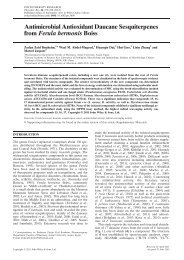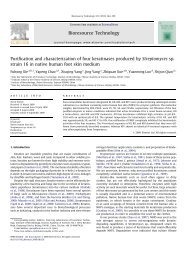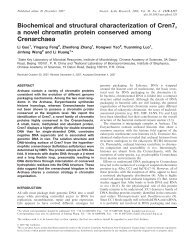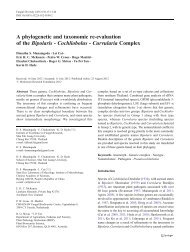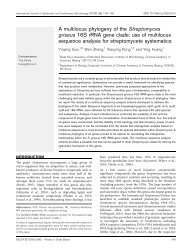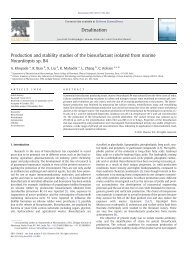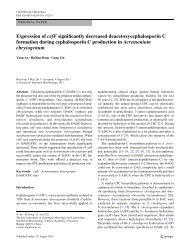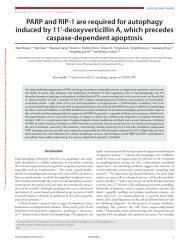Cdc42 regulates microtubule-dependent Golgi positi... - ResearchGate
Cdc42 regulates microtubule-dependent Golgi positi... - ResearchGate
Cdc42 regulates microtubule-dependent Golgi positi... - ResearchGate
Create successful ePaper yourself
Turn your PDF publications into a flip-book with our unique Google optimized e-Paper software.
Hehnly et al.<br />
Figure 3: <strong>Golgi</strong> <strong>positi</strong>oning depends on ARF1 activity and coatomer. A) NRK cells were treated with nocodazole for 2 h; 10 μM<br />
brefeldin A (BFA) was added as the nocodazole was washed out. Shown are confocal micrographs of cells that were fixed at the<br />
indicated time-points and decorated with anti-GM130 antibody. The size bars represent 20 μm. B,C) <strong>Golgi</strong> motility in living NRK cells<br />
was quantified by incubation with NBD-C6 ceramide prior to nocodazole addition; 10 μM brefeldin A (B) or 50 μM BAPTA-AM (C) was<br />
added during the nocodazole wash out. A peripheral region of interest was defined for each cell and the change in peripheral NBD<br />
fluorescence was recorded for 25 min at 37 ◦ C. The mean fluorescence intensity within the region of interest is plotted as a function<br />
of time. The number of experiments is n = 3 for B and C. The standard error in each case is indicated by bars. D) Shown are confocal<br />
micrographs of NRK cells transfected with pEGFP-C1, pEGFP-p23(199–212) and pEGFP-p23(199–212, KK-AA). Cells expressing the<br />
GFP constructs are marked with an asterisk. The cells were pretreated for 2 h with 20 μM nocodazole. Nocodazole was washed off, and<br />
the cells were incubated for 20 min before fixation and decoration with a mouse polyclonal antibody against the <strong>Golgi</strong> marker, GM130.<br />
The bar represents 10 μm. E) The percentage of cells with juxtanuclear <strong>Golgi</strong> membranes at the 20-min time-point was determined after<br />
cells were scored in a blind manner. The average of four experiments is plotted. The bars indicate standard error. The percentage of<br />
cells displaying juxtanuclear <strong>Golgi</strong> is significantly increased in the presence of GFP-p23 (p < 0.05).<br />
cells could undergo adaptations, such as changes in<br />
gene expression, that affect the consequences of <strong>Cdc42</strong><br />
disruption. With this in mind, we sought to determine if<br />
a pharmacological agent that inhibits <strong>Cdc42</strong> acutely had<br />
an effect on <strong>microtubule</strong>-<strong>dependent</strong> <strong>Golgi</strong> re<strong>positi</strong>oning<br />
following nocodazole treatment. For these experiments,<br />
normal rat-kidney (NRK) cells were incubated with the<br />
Rho-family inhibitor, Clostridium difficile toxin B, during<br />
the nocodazole washout (Figure 2A,B). In contrast to<br />
the restoration of normal <strong>Golgi</strong> morphology within 1 h<br />
in the absence of toxin B, the <strong>Golgi</strong> membranes remained<br />
dispersed when toxin B was present (Figure 2A). We next<br />
quantified the rate of <strong>Golgi</strong> re<strong>positi</strong>oning in living NRK cells<br />
by labeling the <strong>Golgi</strong> membranes with NBD-C6-ceramide<br />
and measuring the loss of peripheral fluorescence as a<br />
function of time (see Materials and Methods). Whereas<br />
peripheral fluorescence in control cells decreased in a<br />
linear fashion after the washout, it persisted in the toxin<br />
B-treated cells (Figure 2B). If the <strong>Golgi</strong> <strong>positi</strong>oning is<br />
<strong>Cdc42</strong>-regulated, we expected that it should be sensitive<br />
to toxin B but resistant to the Rho-specific inhibitor C3<br />
transferase. Indeed, we observed that the C3 transferase<br />
had no effect (Figure 2C). Our characterization of <strong>Golgi</strong><br />
re<strong>positi</strong>oning following nocodazole washout supports<br />
a role for <strong>Cdc42</strong> and ARHGAP21 during <strong>microtubule</strong><strong>dependent</strong><br />
<strong>positi</strong>oning of <strong>Golgi</strong> membranes.<br />
<strong>Golgi</strong> <strong>positi</strong>oning depends on ARF1 activity<br />
and coatomer<br />
ARF proteins are essential regulators of vesicular transport<br />
out of the <strong>Golgi</strong> apparatus (26). ARF1 directs <strong>Cdc42</strong><br />
localization (20) and binds to the <strong>Cdc42</strong>-specific GAP,<br />
ARHGAP21 (24). Furthermore, we showed previously that<br />
ARF1 activation is required for dynein recruitment to <strong>Golgi</strong><br />
membranes in vitro (5). Given the central role of ARF<br />
proteins in regulating <strong>Golgi</strong> dynamics and the relationships<br />
among ARF1, ARHGAP21 and <strong>Cdc42</strong>, we expected<br />
that the recovery of <strong>Golgi</strong> membranes from nocodazole<br />
washout should also be sensitive to ARF activity. We<br />
tested whether ARFs are involved in <strong>Golgi</strong> re<strong>positi</strong>oning<br />
by inhibiting the GTP-exchange reaction with brefeldin A.<br />
Kinetic analysis shows that the acute addition of brefeldin<br />
A, just prior to the nocodazole washout, caused the <strong>Golgi</strong><br />
membranes to persist in the cell periphery (Figure 3A,B).<br />
1070 Traffic 2010; 11: 1067–1078






